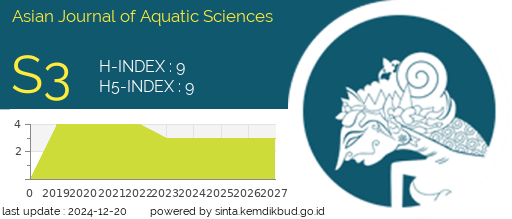THE SPECIES AND ABUNDANCE OF BIVALVIA SPAT IN MANGROVE FOREST SUBSTRATE IN RUPAT ISLAND, BENGKALIS
DOI:
https://doi.org/10.31258/ajoas.8.1.199-127Keywords:
Spat, Bivalvia, Abundance, Mangrove, Polymesoda expansaAbstract
The availability of bivalve spat has a strategic role in ensuring the sustainability of bivalve communities in aquatic ecosystems. This study aims to determine the species, abundance, and timing of bivalve spat settled on the basic substrate of mangrove forest in the intertidal zone of Rupat Island. This research was conducted in June - October 2017. The research was located in the intertidal zone, which is divided into three subzones: upper, middle, and lower. To collect spat bivalve using a net collector, like a tray. This research method was a survey method. The results showed that the bivalve spat had three types: Pilsbryoconcha exilis spat, Polymesoda expansa, and Pharella acutidens. The average abundance is 4.06 ind/m2; the highest abundance of bivalve spats was at the lower subzone, 2.13 ind/m2. The lower subzone was adjacent to the sea and was affected by the tides. From the monthly sampling, October was the highest, with an average abundance of 1.2 ind/m2. Spat catches in June-October were low, and the possibility of a recruit peak of bivalve spat had not happened yet.
Downloads
References
1. Dolorosa, R.G., Dangan-Galon, F. Population Dynamics of the Mangrove Clam Polymesoda erosa (Bivalvia: Corbiculidae) in Iwahig, Palawan, Philippines. International Journal of Fauna and Biological Studies, 2014;1 (6): 11-15.
2. Ngo, N., Quach, K.L. Reproductive Biology of Mud Clam Geloina coaxans in Mangrove Forest of Ca Mau Province, Mekong Delta, Vietnam. Proceedings of International Conference Marine Biodiversity of East Asian Seas: Status, Challenges and Sustainable Development, Nha Trang, Vietnam, December 6-7, 2010
3. Ali, S., Huda, I., Wardiatno, Y., Haji, A.G. Kondisi Vegetasi dan Kerang Geloina Pasca Tsunami dalam Kawasan Ekosistem Mangrove Pesisir Barat Kabupaten Aceh Besar. TORANI Jurnal Ilmu Kelautan dan Perikanan, 2009.
4. Rahmi, I., Ali, M.S. Kepadatan dan Dominansi Macrura di Ekosistem Mangrove Sungai Reuleng Leupung Kabupaten Aceh Besar. FKIP Unsyiah. Banda Aceh, 2012.
5. Agususilo, S. Kelimpahan Larva Anadara spp. (Bivalvia: Arcidae) di Perairan Bojonegara, Teluk Banten, Banten. Fakultas Perikanan dan Ilmu Kelautan, Institut Pertanian Bogor, 2010.
6. Latifah, A. Karakteristik Morfologi Kerang Darah. Departemen Teknologi Hasil Perairan, Fakultas Perikanan dan Ilmu Kelautan, Institut Pertanian Bogor. Bogor, 2011.
7. Islami, M.M. Pengaruh Suhu dan Salinitas terhadap Bivalvia. Oseana, 2013; 38 (2): 1-10
8. Kurniawan, M. Jenis dan Kelimpahan Benih Bivalvia di Subzona Intertidal Kawasan Hutan Mangrove Desa Selat Baru, Kabupaten Bengkalis. Fakultas Perikanan dan Ilmu Kelautan. Universitas Riau. Pekanbaru, 2016.
9. Juandi, B. Shellfish Abundance Relationship Sipetang (Pharella acutidens) and Other Macrozoobenthos in Mangrove Forest, Dumai Riau University Marine Station. Fakultas Perikanan dan Ilmu Kelautan, Universitas Riau. Riau, 2013.
10. Rifardi, R. Tekstur Sedimen, Sampling dan Analisis. Unri Press. Pekanbaru, 2008.
11. PUSHIDROS [Pusat Hidrografi dan Oseanografi] TNI AL. Daftar Pasang Surut Tide Tables, 2017, TNI AL. Jakarta, 2017.
12. Odum, E.P. Dasar-dasar Ekologi (Fundamental of Ecology). Diterjemahkan Oleh T. J. Samingan. Gajah Mada Universitas Press, Jakarta, 1993; 679p
13. [BPS] Badan Pusat Statistik Kabupaten Bengkalis. Kabupaten Bengkalis dalam Angka. Badan Pusat Statistik Kabupaten Bengkalis, 2014.
14. Rizal, R., Emiyarti, E., Abdullah, A. Pola Distribusi dan Kepadatan Kijing Taiwan (Anadonta woodiana) di Sungai Aworeka Kabupaten Konawe. Jurnal Mina Laut Indonesia, 2013; 2(6): 142 – 153.
15. Kementerian Lingkungan Hidup. Keputusan Menteri Negara Lingkungan Hidup Nomor 51 Tahun 2004. Tentang. Baku Mutu Air Laut. KEPMENLH. Jakarta, 2004.
16. Tanjung, A. The Collection Pharella acutidens (Broderip & Sowerby, 1828) Smaller Than 20 Mm as an Indication for the Time of Spat Settlement in the Mangrove Forest of Riau University, Dumai. Proceedings of the International Seminar. Fakultas Perikanan dan Ilmu Kelautan Universitas Riau. Pekanbaru, 2012.
17. Clemente, S. Ecology and Population Dynamics of the Mangrove Clam Polymesoda erosa (Solander 1876) in the Mangrove Ecosystem. National Institute of Oceanography, Dona-Paula, Goa- India, 2007.
18. Anne, P. Karakteristik Asam Lemak dan Kolesterol Kijing Lokal (Pilsbryoconcha Exillis) dari Situ Gede Bogor Akibat Proses Pengukusan. Fakultas Perikanan dan Ilmu Kelautan. Institut Pertanian Bogor. Bogor, 2009.
19. Clemente, S., Baban, I. Recruitment of Mud Clam Polymesoda erosa (Solander, 1876) in a Mangrove Habitat of Chorao Island, Goa. National Institute of Oceanography, Brazilian Journal of Oceanography, 2011; 59(2):153-162
20. Starr, P. Clams and Cockles in the Mekong Delta. Fisheries Research and Development in the Mekong Region. Mekong River Commission for Sustainable Development, 2009; 15:1
21. Efriyeldi, E. Ekobiologi Kerang Sipetang (Pharella acutidens Broderip & Sowerby, 1828) di Ekosistem Mangrove Pesisir Kota Dumai, Riau. Sekolah Pascasarjana, Institut Pertanian Bogor. Bogor, 2012.
22. Sarong, M.A., Boer., M., Dahuri, R., Wardiatno, Y., Sukimin, S. Pengelolaan Kerang Mangrove Geloina erosa Berdasarkan Faktor Biologi di Kawasan Pesisir Barat Kabupaten Aceh Besar. Sekolah Pascasarjana Institut Pertanian Bogor. Bogor, 2010.
Downloads
Published
Issue
Section
License
Copyright (c) 2025 Rizki Oktavian, Syafruddin Nasution, Zulkifli Zulkifli (Author)

This work is licensed under a Creative Commons Attribution 4.0 International License.






